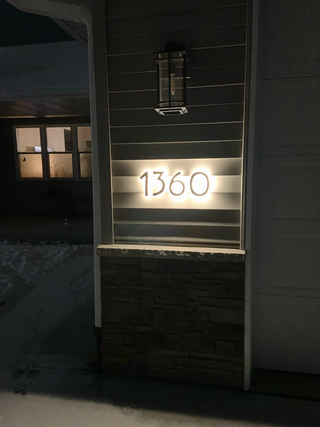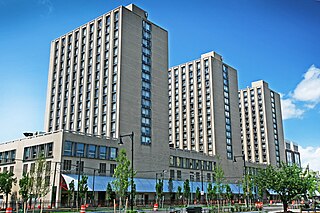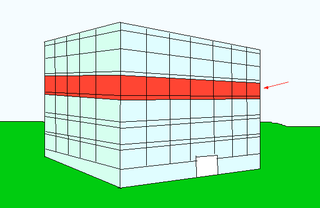Hilbert's paradox of the Grand Hotel is a thought experiment which illustrates a counterintuitive property of infinite sets. It is demonstrated that a fully occupied hotel with infinitely many rooms may still accommodate additional guests, even infinitely many of them, and this process may be repeated infinitely often. The idea was introduced by David Hilbert in a 1925 lecture "Über das Unendliche", reprinted in, and was popularized through George Gamow's 1947 book One Two Three... Infinity.

A postal code is a series of letters or digits or both, sometimes including spaces or punctuation, included in a postal address for the purpose of sorting mail.

Ancient Roman architecture adopted the external language of classical ancient Greek architecture for the purposes of the ancient Romans, but was different from Greek buildings, becoming a new architectural style. The two styles are often considered one body of classical architecture. Roman architecture flourished in the Roman Republic and to an even greater extent under the Empire, when the great majority of surviving buildings were constructed. It used new materials, particularly Roman concrete, and newer technologies such as the arch and the dome to make buildings that were typically strong and well engineered. Large numbers remain in some form across the former empire, sometimes complete and still in use today.

An apartment, flat, or unit is a self-contained housing unit that occupies part of a building, generally on a single storey. There are many names for these overall buildings. The housing tenure of apartments also varies considerably, from large-scale public housing, to owner occupancy within what is legally a condominium, to tenants renting from a private landlord.

The ʻIolani Palace was the royal residence of the rulers of the Kingdom of Hawaiʻi beginning with Kamehameha III under the Kamehameha Dynasty (1845) and ending with Queen Liliʻuokalani (1893) under the Kalākaua Dynasty, founded by her brother, King David Kalākaua. It is located in the capitol district of downtown Honolulu in the U.S. state of Hawaiʻi. It is now a National Historic Landmark listed on the National Register of Historic Places. After the monarchy was overthrown in 1893, the building was used as the capitol building for the Provisional Government, Republic, Territory, and State of Hawaiʻi until 1969. The palace was restored and opened to the public as a museum in 1978. ʻIolani Palace is the only royal palace on US soil.

221B Baker Street is the London address of the fictional detective Sherlock Holmes, created by author Sir Arthur Conan Doyle. In the United Kingdom, postal addresses with a number followed by a letter may indicate a separate address within a larger, often residential building. Baker Street in the late 19th century was a high-class residential district, and Holmes's apartment would probably have been part of a Georgian terrace.

House numbering is the system of giving a unique number to each building in a street or area, with the intention of making it easier to locate a particular building. The house number is often part of a postal address. The term describes the number of any building with a mailbox, or even a vacant lot.

An address is a collection of information, presented in a mostly fixed format, used to give the location of a building, apartment, or other structure or a plot of land, generally using political boundaries and street names as references, along with other identifiers such as house or apartment numbers and organization name. Some addresses also contain special codes, such as a postal code, to make identification easier and aid in the routing of mail.

The Albrechtsburg is a Late Gothic castle erected from 1471 till about 1495. It is located in the town centre of Meissen in the German state of Saxony. It is situated on a hill above the river Elbe, adjacent to the Meissen Cathedral.

Clara Dickson Hall is a residence hall located on the North Campus of Cornell University. For many years it was the largest dormitory on North Campus, housing over 460 students, until construction of Ginsburg Hall and Ganędagǫ Hall in 2022. Clara Dickson is also home to the Multicultural Living Learning Unit, or "McLLU".

In Roman architecture, an insula was one of two things: either a kind of apartment building, or a city block. This article deals with the former definition, that of a type of apartment building.
ISO 4157 is an ISO standard for construction drawings and designation systems.

Housing in Japan includes modern and traditional styles. Two patterns of residences are predominant in contemporary Japan: the single-family detached house and the multiple-unit building, either owned by an individual or corporation and rented as apartments to tenants, or owned by occupants. Additional kinds of housing, especially for unmarried people, include boarding houses, dormitories, and barracks.

The Strindberg Museum is a museum in Stockholm, Sweden. It is dedicated to the writer August Strindberg (1849-1912) and located in his last dwelling. The site is in the building he nicknamed "Blå tornet" at Drottninggatan 85 on the corner of Drottninggatan and Tegnérgatan in the borough of Norrmalm in central Stockholm.

The Villa Romana del Casale is a large and elaborate Roman villa or palace located about 3 km from the town of Piazza Armerina, Sicily. Excavations have revealed Roman mosaics which, according to the Grove Dictionary of Art, are the richest, largest and most varied collection that remains, for which the site has been designated as a UNESCO World Heritage Site. The villa and artwork contained within date to the early 4th century AD.

The Boston University housing system is the 2nd-largest of any private university in the United States, with 76% of the undergraduate population living on campus. On-campus housing at BU is an unusually diverse melange, ranging from individual 19th-century brownstone town houses and apartment buildings acquired by the school to large-scale high-rises built in the 60s and 2000s.

21 West Street, also known as Le Rivage Apartments, is a 33-story building located in the Financial District of Lower Manhattan in New York City, on Morris Street between West Street and Washington Street. It was built in 1929–1931 as a speculative office tower development in anticipation of an increased demand for office space in Lower Manhattan. The building was converted into apartments in 1997 and was renamed Le Rivage.

A storey or story, is any level part of a building with a floor that could be used by people. Plurals for the word are storeys (UK) and stories (US).

Palazzo Aragona Gonzaga, also known as Palazzo Negroni, is a sixteenth-century palace in Rome, Italy. It was once the residence of Cardinal Scipione Gonzaga. During that time his cousin Luigi Gonzaga also lived there, as did the poet Torquato Tasso from 1587 to 1590. In the nineteenth century it belonged to the Galitzin family, and so is also known as Palazzo Galitzin.

The Museum of the Liberation of Rome is located in an apartment building at Via Tasso 145, Rome, close to the basilica of St. John Lateran. It records the period of German occupation of Rome in the Second World War and its subsequent liberation. The building housing the museum was used by the SS to torture members of the Italian Resistance in the first half of 1944.


















